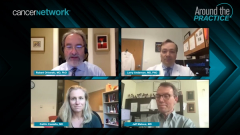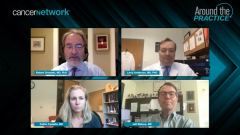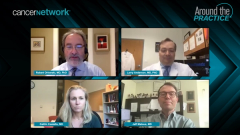
Maintenance Therapy for Transplant-Ineligible MM
Take-home points from the MAIA trial of daratumumab plus lenalidomide and dexamethasone as therapy for patients with newly diagnosed transplant-ineligible multiple myeloma, and recommendations regarding maintenance therapy following the use of a triplet regimen.
Episodes in this series

Robert Orlowski, MD, PhD: Let’s move to the next polling question. When you initiate a triplet therapy, how often do you continue that into the maintenance setting? Your options are No. 1, always; No. 2, most of the time; No. 3, some of the time; No. 4, rarely; and No. 5, never. Caitlin let’s say you do VRd [bortezomib, lenalidomide, dexamethasone] lite or daratumumab-Rd [lenalidomide, dexamethasone] on this transplant-ineligible patient. What would you do for maintenance afterward?
Caitlin Costello, MD: I’m going to be a stickler here because for semantic purposes, we’re talking about continuous therapy vs post-transplant maintenance per se. We’re talking about a patient who doesn’t go to transplant and is going to stay on continuous therapy for as long as they can tolerate if it’s working. I saw a comment from the audience saying that patients would go on a doublet if they could drop the dexamethasone. Many of us who are referring to doublets are talking about dexamethasone plus something else as opposed to 2 active drugs plus or minus dexamethasone. I’m comfortable with patients who are on long-term continuous therapy dropping the dexamethasone. That’s the least active of the triplets that we do and the most active in terms of toxicity. If I can keep people on a monoclonal antibody plus or minus lenalidomide or a monoclonal antibody plus or minus a proteasome inhibitor, I’m going to try and keep the doublet of the 2 most active drugs. We’ve seen from the MAIA data that that’s practical. We’ve seen that we can keep patients on therapy for a very long time. There are maintenance data post-transplant saying we can get people off the dexamethasone. The SWOG-S0777 study also looked at trying and get people off dexamethasone. We should be trying to get people off dexamethasone because that’s often the biggest thing that affects quality of life.
Robert Orlowski, MD, PhD: We do have some differences of opinion on the polling questions because it seems as though there’s an even split between keeping people on triplet maintenance most of the time, some of the time, and rarely. Jeff, where do you fall on the spectrum? Are you always at the top or never at the bottom if you want to be controversial?
Jeff Matous, MD: When I start out, of course, in my head it’s always. But then you treat patients, and after giving several cycles to patients say there’s treatment fatigue. The more important goal is to keep people on therapy longer and not have them abort therapy soon because of toxicity or adverse effects. I’m right in line with Caitlin: the dexamethasone is the first thing to go. That shortens your clinic appointments by 10 minutes each time you see the patient. I try to keep both drugs going in a certain setting, like DRd [daratumumab, lenalidomide, dexamethasone]. The more challenging question is what do you do with an RVd [lenalidomide, bortezomib, dexamethasone] or RVd [lenalidomide, bortezomib, dexamethasone] light patient? I think 8 cycles is what they gave in SWOG-0777. If you got 8 cycles in those patients, what do you do with those patients after that?
Robert Orlowski, MD, PhD: Hopefully in the future, what we’re trying to do through SWOG is set up a study for frail patients, so there would be a 3-arm trial. One arm would get VRd [bortezomib, lenalidomide, dexamethasone] light followed by R [lenalidomide] maintenance. A second arm would get DRd [daratumumab, lenalidomide, dexamethasone] followed by R [lenalidomide] maintenance. The third arm would be DRd [daratumumab, lenalidomide, dexamethasone] followed by DR [daratumumab, lenalidomide] maintenance. If we can get the results from that study a few years down the road, then they would help to answer a lot of these questions that we’ve been struggling with.
Transcript edited for clarity.
Newsletter
Stay up to date on recent advances in the multidisciplinary approach to cancer.









